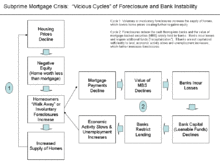The terms virtuous circle and vicious circle, also known respectively as virtuous cycle and vicious cycle, refer to complex chains of events that reinforce themselves through a feedback loop.[1] A virtuous circle has favorable results, while a vicious circle has detrimental results.
Both circles are complex chains of events with no tendency toward equilibrium (social, economic, ecological, etc.)—at least in the short run. Both systems of events have feedback loops in which each iteration of the cycle reinforces the previous one (positive feedback). These cycles will continue in the direction of their momentum until an external factor intervenes and breaks the cycle.
A well-known example of a vicious circle in economics is hyperinflation.
Examples
Vicious circles in the subprime mortgage crisis
The contemporary subprime mortgage crisis is a complex group of vicious circles, both in its genesis and in its manifold outcomes, most notably the late 2000s recession. A specific example is the circle related to housing. As housing prices decline, more homeowners go "underwater", when the market value of a home drops below the mortgage on it. This provides an incentive to walk away from the home, increasing defaults and foreclosures. This, in turn, lowers housing values further from over-supply, reinforcing the cycle.[2]
The foreclosures reduce the cash flowing into banks and the value of mortgage-backed securities (MBS) widely held by banks. Banks incur losses and require additional funds, also called “recapitalization”. If banks are not capitalized sufficiently to lend, economic activity slows and unemployment increases, which further increase the number of foreclosures.
Economist Nouriel Roubini described the vicious circles within and across the housing market and financial markets during interviews with Charlie Rose in September and October 2008.[3][4][5]
Designing ecological virtuous circles
By involving all stakeholders in managing ecological areas, a virtuous circle can be created where improved ecology encourages the actions that maintain and improve the area.[6]
Other
Other examples include the poverty cycle, sharecropping, and the intensification of drought.
See also

- Catch-22 (logic)
- Causal loop diagram
- Cycle of poverty
- Closed timelike curve
- Endogeneity (econometrics)
- Positive feedback
- Rational addiction
- Reflexivity (sociology)
- Self-fulfilling prophecy
- Spiral of silence
- Unintended consequences
References
- ^ Charles Webel, Johan Galtung (19 March 2012). Handbook of Peace and Conflict Studies. Routledge. ISBN 9780203089163. Retrieved 19 March 2012.
- ^ "WSJ-Vicious Cycle in Subprime Crisis". Online.wsj.com. 2008-11-18. Retrieved 2013-09-05.
- ^ "Roubini & Panel". Charlie Rose. Retrieved 2013-09-05.
- ^ "Rose & Roubini Discussion". Charlierose.com. Archived from the original on 2013-04-01. Retrieved 2013-09-05.
- ^ "Rose & Roubini". Charlierose.com. Retrieved 2013-09-05.
- ^ Morrison Scott A (March 2016). "Designing virtuous socio-ecological cycles for biodiversity conservation". Biological Conservation. Elsevier. 195: 9–16. doi:10.1016/j.biocon.2015.12.022.
External sources
- Schlesinger, L.; Heskett, J. (1991). "Breaking the cycle of failure in services". Sloan Management Review. 31: 17–28.
- Rational Choice with Passion:Virtue in a Model of Rational Addiction – In this link the author uses Aristotelian virtue as a mediator between passion and reason in the construction of utility/consumption functions in an esoteric part of consumer behaviour theory related to decision making in addictive situations.
- China: A Stabilizing or Deflationary Influence in East Asia? The Problem of Conflicted Virtue – In this link the author is using virtue in the sense of a positive outcome (balance of payments surplus) that conflicts with long term regional growth and stability.
